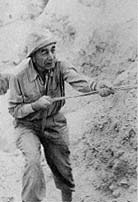
Unearthing a single unique find or deciphering a significant inscription can bestow archaeological immortality on the finder. Nahman Avigad discovered many rare artifacts and deciphered many inscriptions in his time, but it is Jerusalem’s thriving Jewish Quarter that is his living legacy. For 19 years before the 1967 Six-Day War, the Quarter had suffered neglect and outright destruction under its Jordanian rulers. Coming under Jewish control for the first time in 1,900 years, the Old City of Jerusalem, in which the Jewish Quarter is located, presented a historical archaeological opportunity. Work soon commenced south of the Temple Mount, at the City of David and within the Jewish Quarter itself In a happy match of an extraordinary opportunity with an extraordinary archaeologist, Avigad was persuaded to put off impending retirement to oversee excavation of the Quarter. Retirement, it turned out, would have to wait quite a while longer. Digging almost nonstop for 14 years under pressure from builders eager to begin housing construction, Avigad and his team uncovered treasures unseen in Jerusalem for millennia: Fortifications that helped King Hezekiah fend off Sennacherib’s attack in 701 B.C.; arrowheads from Nebuchadnezzar’s onslaught in 586 B.C.; and poignant human remains from the Roman sack of 70 A.D. But Avigad found much more than reminders of the city’s past woes: His team uncovered signs that ancient Jerusalem was significantly larger than many scholars previously believed and recovered whole neighborhoods of unmatched splendor. With the excavations complete, many of the ancient treasures are now on view within the rebuilt Quarter. Nitza Rosovsky takes us on a walking tour of this living museum and details Avigad’s work of uncovering “A Thousand Years of History in Jerusalem’s Jewish Quarter.”

Rosovsky is a curator at the Harvard Semitic Museum, coordinating exhibits, catalogues, docent training, lecture series, public relations, fund raising events and archaeological tours. She is the author of the recently revised Jerusalem Walks (Henry Holt, 1992) and coauthor with Joy Ungerleider-Mayerson of The Museums of Israel (Abrams, 1989). Rosovsky writes and lectures frequency on travel, photography and archaeology. Her articles have appeared in the New York Times, The New Republic and BAR (“Traveling Companions—A Guide to Guidebooks,” BAR 11:06).

Nahman Avigad had a long and special relationship with BAR, to which he contributed three major articles (“How the Wealthy Lived in Herodian Jerusalem,” BAR 02:04; “Jerusalem Flourishing—A Craft Center for Stone, Pottery and Glass,” BAR 09:06; and “Jerusalem in Flames—The Burnt House Captures a Moment in Time,” BAR 09:06). He also inspired and provided vital help on several other BAR articles, including the Jewish Quarter article in this issue (“A Thousand Years of History in Jerusalem’s Jewish Quarter”). It is therefore fitting that he be memorialized not only with an appreciation by his close colleague Frank M. Cross (“Nahman Avigad: In Memoriam”), but also by BAR editor Hershel Shanks (“Nahman Avigad: 1905–1992”).
An original member of the Dead Sea Scrolls editing team, Cross is one of the world’s leading scholars of the Hebrew Bible and a fervent friend as well as colleague of Nahman Avigad. The Hancock Professor of Hebrew and Other Oriental Languages at Harvard University, a position he has held since 1957, Cross will retire this May and become professor emeritus. Among his many publications are such highly regarded books as The Ancient Library at Qumran and Modern Biblical Studies (Baker Book House, rev. ed. 1980) and Canaanite Myth and Hebrew Epic: Essays in the History of the Religion of Israel (Harvard Univ. Press, 1973).
“The Pomegranate Scepter Head—From the Temple of the Lord or from a Temple of Asherah?” summarizes one of Professor Avigad’s last scholarly debates. Recently challenged by his former student, Aharon Kempinski, on his reading of the inscription on the ivory pomegranate bought by the Israel Museum for $550,000 in 1988, Avigad vigorously upholds his position that the pomegranate is an artifact from the Jerusalem Temple.

Although few people would use the derogatory term “hick” to describe Jesus, many scholars and lay people do believe that Jesus’ upbringing was provincial. The truth, as Richard A. Batey shows in “Sepphoris—An Urban Portrait of Jesus,” is that Jesus grew up within walking distance of a great metropolis, and, according to Batey, Sepphoris’ influence can be detected in Jesus’ ministry.
Batey is the W. J. Millard Professor of Religion at Rhodes College in Memphis, Tennessee. He was assistant director of the University of South Florida’s excavations at Sepphoris from 1984 to 1989. Batey currently chairs the Society of New Testament Studies seminar on “Archaeology and the New Testament.” His books include The Letter of Paul to the Romans (R.B. Sweet, 1969), Jesus and the Poor (Harper & Row, 1972) and, most recently, Jesus and the Forgotten City (Baker Book House, 1991), from which his article has been adapted.

Continuing publicity surrounding the Dead Sea Scrolls has catalyzed discussions in supermarket check-out lines as well as university faculty lounges across the country. Have the merits of the case been lost in a sea of rhetoric? Has an academic difference of opinion turned into a witch-hunt for villains? John W. Wright takes a critical look at BAR’s role in the popularization of the topic in “Another View of the ‘Dead Sea Scrolls Scandal.’”
Currently a visiting assistant professor at the University of Notre Dame, where he received his Ph.D. in 1989, Wright’s special interest is in the area of Second Temple Judaism, especially during the Persian period. The excess energy he once spent running marathons is now taken by his children, ages 5, 3, and year-old twins.

